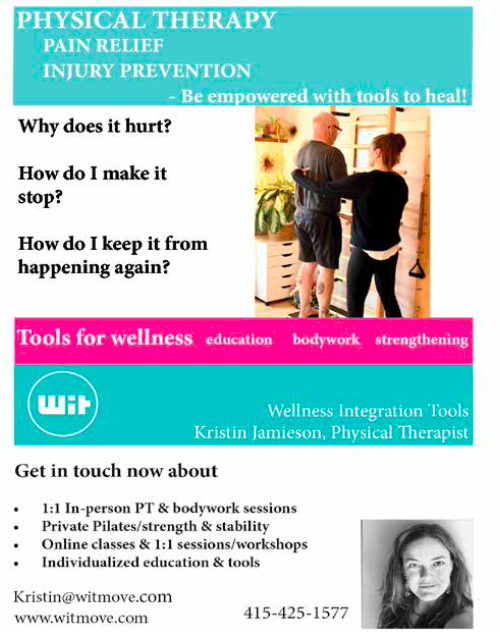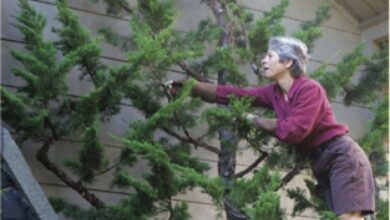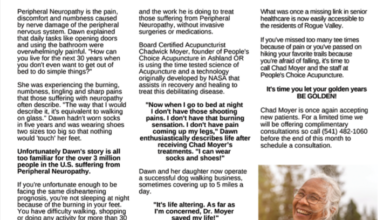Interview – Kristin Jamieson Self-Care ~ Injury Prevention ~ Empowerment
Introducing Kristin Jamieson. Kristin is a Physical Therapist and Founder of WIT (Wellness Integration Tools). She recently relocated with her husband, son, and dog from the Bay Area. Kristin brings with her over 21 years of experience in the fields of Physical Therapy, fascial release, Pilates, and bodywork. In today’s interview, I speak with Kristin about her philosophy and mission for assisting all her clients in living richer and more fulfilled lives.
Hi Kristin, thanks so much for speaking with me today. To begin with, welcome to Southern Oregon!!
Thank you! My family and I are loving Ashland.
Kristin, please tell us about your background and how you came to be a physical therapist.
I grew up in Colorado, and before PT school, I was planning on getting my Ph.D. in Neuroscience. I have always been driven by knowledge, wanting to go deeper, know more. I worked in a research lab for several years after college. After a time, I realized I wanted to work more directly with people and decided to go to PT school. I’ve now been practicing hands-on, manual-based bodywork and PT for close to 22 years.
What are you most passionate about in the work you do?
I would say I am most passionate about empowering people with the knowledge and the tools to help themselves heal and working towards creating a culture of prevention. I believe that people can do SO much to help themselves recover from injury, stay well, stay active, and stay out of pain. But I find that often they are missing critical pieces of the puzzle. My goal is to help them piece the whole picture together.
Please talk about the root of injuries and creating a culture of prevention.
Our systems crave balance; our bodies operate on feedback loops to maintain equilibrium. Be it our internal temperature, hormone levels, muscular systems, etc. Injury or disease happens when our systems are out of balance. I believe that many musculoskeletal injuries occur when there is too much tension somewhere in the system. Suppose we work to increase awareness and learn to address and release tension BEFORE it becomes an injury. In that case, we can create a culture of prevention.
What is fascia, and why is it important?
Fascia is a 3-dimensional web of connective tissue that surrounds and connects EVERYTHING in our bodies.
From just under our skin, all the way down to the level of the bone. It surrounds every nerve, artery, vein, muscle, muscle fiber, even every cell! It is the extracellular matrix, the glue that holds us together. And it is ALL connected. This fascial web needs to be mobile, fluid, dynamic, and hydrated for optimal functioning. We can get “sticky spots,” adhesions, dense and restricted areas in our body, creating tension in the system. Imagine a sheet spread out on the floor – and you take one place and twist it up, creating bands of pull that radiate out from that spot. This web of fascia is like that. If you have a shoulder injury from 15 years ago that still has some sticky areas, you can have bands of pull radiating into your neck or your low back. When you pick up that box from the floor or twist in yoga class, you now have this increased tension (increased stress/pull) in these other areas of your body, this can lead to injury and pain.
What is fascial release?
Sometimes, stretching and movement alone is enough to free up areas of tension and adhesion in the fascial network. Still, a lot of the time, they need to be physically released. Releasing sticky spots can be done through bodywork (massage, rolfing, deep tissue, myofascial release, trigger point, acupuncture, Graston, etc.). Or self-massage (using your own hands, a foam roller, massage balls, etc.). Releasing this tissue is crucial to the optimal functioning of our systems, both for our mobility and our stability.
Please tell us more about your philosophy around mobility and stability.
If you can start to picture that this fascial web surrounds and connects EVERYTHING in your body. And you know that when a muscle contracts, it has to shorten and lengthen (or slide and glide). Suppose the fascia surrounding a muscle (and each muscle fiber) is rigid, adhered, sticky, etc. In that case, it can impair the slide and glide of the muscle tissue. Decreased slide and glide limits mobility and affects the muscle’s ability to contract, impacting strength and stability. For us to function optimally – we need to be BOTH mobile and stable.
What are your specialties in physical therapy?
Broadly stated, I would say I specialize in fascia: fascial release, the role of fascia in movement, function, and overall health. The process around how I work is something I call Integrated Fascial Release (IFR). I help people access optimal health using accessible tools that integrate body and mind. Many people are disconnected from their bodies (or at least parts of their bodies). I use fascial release (either hands-on in the clinic or self-fascial release done independently at home) as the tool to help bridge the gap and get people more connected with their bodies. As the saying goes, “you have to feel it in order to heal it.” Once you can feel what is happening on the INSIDE, you are better poised to prevent injury, release pain and tightness, stay active, and live life to the fullest.
What are your specialties in Pilates?
I suppose being a physical therapist, working with injury and rehabilitation for so long, changes my approach to Pilates. I am never thinking about Pilates simply as an “exercise,” but rather as a functional tool to work with the body and tease out movement patterns. One of my favorite Pilates “tools” for in-person sessions is the CoreAlign machine. It creates an element of dynamic stability/instability that allows people to connect to their system profoundly. I have seen people integrate new patterns and new movements into their bodies in just one session.
Please tell us about your online classes.
When the pandemic started, I wanted to have things to offer my clients when I was not seeing people in person. These classes have developed into some of my favorite parts of the week.
I have a weekly 60 min “core” class called Just the Good Stuff. On Saturdays at 9 am, I consider these foundational stability exercises that will give you a solid jumping-off point for all other types of activity.
I teach a weekly Integrated Fascial Release (IFR) Class; this is essentially a full-body guided fascial release class. It’s 90 min of self-care; you get to slow down, drop into your body, release the tight spots. You often finish feeling like you have had a full body massage. IFR classes are on Wednesday evenings from 5-6:30 pm, we use massage balls and foam rollers.
More recently, I started an 8-week Integrated Fascial Release course called Finding Your Baseline. Each week we cover a different area of the body – basic anatomy, common “issues” (shoulder impingement, low back pain, “sciatica,” “tech neck,” etc.), guided fascial release, self-care, and stability for that area. These are ongoing; you can find current dates and times on my website. The 8-week course would be for anyone interested in taking a deeper dive into ongoing self-care and maintenance of their body. 
Please tell us about your company WIT.
I started WIT (Wellness Integration Tools) in 2016 to educate people and create tools for wellness. Initially, I was going to educate about fascia and fascial release – but then people asked which tools they should use. And being incredibly passionate and “geeky” about fascial release, I wasn’t 100% satisfied with the tools that were on the market. So I started creating my own. At present, I have a massage ball I made called the WIT Ball. It has a particular design that allows for optimal fascial release (it had to have the proper grip and give). It is also on a string that lets you adjust it easily when rolling against the wall. I also have a little WIT Mini Ball to get into more minor spots. I am working on another product called the WIT Mobile. It is really fun to try to take what I do hands-on with people and figure out ways to recreate that for people to do independently. That is the aim of these products.
Please introduce us to the services that you are offering?
• IN-PERSON sessions
• Home clinic, 60 min PT sessions & 60 min Pilates sessions, or a mix of both. These sessions are cash pay.
• Kleiman and Stamper Physical Therapy (Tu, Fri, & Sat).
Sessions can be billed to insurance.
• Online 1:1 sessions via Zoom
• Online classes and workshops as mentioned above.
Can you share some customer success stories with us?
Well, the most gratifying times for me are when a client tells me that they were able to use something we have worked on together to get themselves out of pain. To empower people that way is such a gift. When someone wakes up in pain and does not immediately go into panic mode; but can slow down, get out their massage ball, release tightness, and decrease their pain, that is a success.
Do you have some favorite testimonials you can share?
AVOID SURGERY
“Some years ago, I think about 2004, due to repetitive stress (from writing and such), my hands were so cramped up that I could not write, I could not tie my own shoes, I could not even button my own buttons. All Kaiser could suggest was surgery. Instead, I consulted Kristin, who worked on loosening up the knots; she had the expertise to loosen up tension all the way up my arms to neck, shoulders, and everything else contributing to the congestion and tightness. In short order, my hands were freed up to move, and she taught me the exercises necessary to keep the mobility she provided me able to continue, which it has for ten years now. I highly recommend Kristin for her expertise, her uncanny knowledge of how to open up any and all “stuck” places, as well as to teach those who consult her how to maintain the benefits she offers.”
— DEBORAH B, SAN FRANCISCO
INDIVIDUALIZED TREATMENT
“Kristin is a unique physical therapist. While she shares the goals of client rehabilitation and improved functioning with her colleagues, her treatment approach goes well beyond these goals. In consultation with each client, Kristin develops a highly individualized treatment plan which includes educating the client about the physical mechanics of the body that underlie their treatment needs. Kristin’s ultimate goal is to teach each client techniques and methods for self-care, which they can use when physical issues arise. I came to Kristin after my physical therapist agreed with me that the multiple rounds of conventional physical therapy—he demonstrated exercises for me to do at home- had not moved the needle on my pain or functionality. Kristin was able to quickly provide a diagnosis that made sense to me, and we worked diligently together to resolve my pain and functioning. Along the way, Kristin taught me various techniques and tools using a foam roller, therapy balls, and bands, which allowed me to self-treat. This is critically important to me as I travel extensively on journeys that require significant physical exertion. I am no longer afraid to embark on a new adventure. I am confident that the techniques and tools Kristin has shown me, which are the first things to go in my suitcase, will allow me to fully experience my passion for travel. I can say without exaggeration that Kristin has set me free.”
— ANN, AGE 67, SF
Kristin, tell us about your safe gardening class idea.
Since moving to Ashland, I have been blessed with being able to garden, dig in the dirt and get closer to nature – which was a huge reason we moved here. However, being a physical therapist – I can never entirely shut off my “PT” brain. Over the years, I have had many clients talk about “overdoing it” while gardening. And now – I am getting to know firsthand how hard it can be on your body. I have started to think about ways that I might be able to help people navigate the gardening road. I think as covid restrictions lessen, it might be great to do a “safe gardening class” or “gardening body prep” class. This class might address common issues and ways people can prepare their bodies and release and treat problems after the fact (low back tightness, hand and knee pain, etc.).
Finally, what are the next steps for anyone who is interested in learning more about your work or wanting to schedule an appointment with you?
People can contact me via email at Kristin@witmove.com to set up a quick consult and find out more about how we might work together. Or they can schedule directly or sign up for classes through my website at witmove.com.
Learn More:
Wellness Integration Tools (WIT)/ Kristin Jamieson PT
216 W. Nevada St, Ashland
witmove.com
415-425-1577





